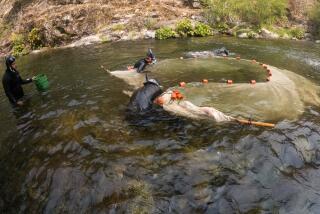State River-Rafters Warm to Prospect of Huge Snowmelt : Adventure: They expect abundant water from now through summer. Wilderness rivers provide the wildest rides.
- Share via
Spring at last. And after a winter as stormy as this last one, an adventurous traveler’s thoughts turn to river-running.
“We have so much water,” says Diane Strachan, a former river guide and spokeswoman for California Outdoors, the trade association that represents 50 of the state’s roughly 65 river outfitters. “Basically, what this means is that we will have a full season (of rafting), all the way through the summer into September, which is rare in California.”
Hard-core rafters are already in the water, but the outfitter rafting season for beginners and intermediates doesn’t begin in earnest until late April, when temperatures are higher. Gregg Armstrong, president of All-Outdoors Whitewater Rafting Trips in Walnut Creek, predicts his company will still be running half-a-dozen rivers when November begins. (Since water volumes vary from river to river and week to week, specific predictions are difficult, especially on rivers not controlled by dams.)
On Feb. 1, the state Department of Water Resources estimated statewide snowpacks at 150%-190% of normal, 175% of normal at Mammoth. As that snow melts it feeds the state’s rivers.
Statewide, California Outdoors figures show, outfitters took 281,500 people on river trips in 1993. (Last year’s figures are not yet available.) The most-frequently run river in the state is the South Fork of the American; the nearest major rafting river to Los Angeles County is the Kern. Those who reach the rivers before the summer crowds, Strachan says, “really have more of a wilderness experience.” Armstrong says his company’s busiest weekends each year are the three that follow the Fourth of July.
Outfitters categorize rivers in several ways. Those known as “summer rivers” are usually dam-controlled and relatively mild, and support rafting traffic through spring and summer. “Spring rivers” are usually more challenging, often undammed, and usually run April-June. On some , that will stretch through July this year.
The other term to watch is the classification of a river’s difficulty: I-VI, from least- to most-challenging; Class VI rapids are usually considered unrunnable. Outfitters usually recommend Class II and III rivers to beginners in average physical shape. They also suggest that parents with children under 12 should consult carefully with outfitters to be sure itineraries are suitable for young children. (Age limits vary, and some outfitters on mild rivers offer trips designed for children as young as 4.)
One resource is the California Outdoors Hotline (800-552-3625), where consumers leave their addresses and receive a directory of 50 California river outfitters. Some questions to ask prospective outfitters: How long has the company been operating on the river? What kind of vessels does the company provide? What are the meals like? Are tents or sleeping bags provided? What background do the guides have? Who trains them? What provisions are made for children? Can the company provide references?
The state’s most popular summer rivers, also runnable in spring, include the following. (Descriptions were gleaned from veteran outfitters.)
* Upper Klamath River (class IV, 1-2 days, 5-20 miles) near the Oregon border. Demanding river, best suited to experienced rafters.
* Trinity River (class III, 1-2 days, 10-20 miles) near Redding. Recommended for beginners and families.
* Cache Creek (class II-III, 1-2 days, 6-12 miles) in Yolo County. One of the state’s easiest rivers.
* Middle Fork of the American River (class III-IV, 1-3 days, up to 17 miles) near Auburn. Waterfalls and side hikes; novices should be fit.
* South Fork of the American River (class III, 1-2 days, 20 miles) near Placerville. Recommended for beginners and families; not a remote wilderness experience.
* Main Tuolumne River (class IV, 1-3 days, up to 18 miles) near Sonora. Boulders, waterfalls, challenging rapids. Recommended for experienced rafters only.
* Lower Kern River (class III-IV, 1-2 days, 20 miles) near Bakersfield. Recommended for active beginners.
* Lower Klamath River (class III, 1-4 days, 10-30 miles) in Northern California near Happy Camp. Known as an easy, family-friendly river, with waterfalls and side hikes.
The state’s top spring rivers include the following: the North Fork of the American River (class IV, 1 day, 8 miles) near Auburn; the Merced River (class III-IV, 1-2 days, 13-26 miles) near Yosemite; the Kings River (class III, often recommended for beginners, 1-2 days, 10-20 miles) near Fresno; the Upper Kern River (class II-V, 2 hours-2 days, 3-10 miles) above Kernville, and the Kaweah River (class IV-IV+, 1-2 days, 14 miles) east of Visalia. Outfitters caution that when waters are running their fastest, each of those rivers can be unsafe for beginners.
Even more demanding waters can be found on the Salmon River (class V; not to be confused with Oregon’s Salmon River) southwest of Yreka; the North Fork of the Yuba River (class IV) near Yuba City; the Upper Kern River (class IV-V) above Lake Isabella, and the North Fork of the Stanislaus River (class IV+) between Yosemite National Park and Sacramento.
More to Read
Sign up for The Wild
We’ll help you find the best places to hike, bike and run, as well as the perfect silent spots for meditation and yoga.
You may occasionally receive promotional content from the Los Angeles Times.







